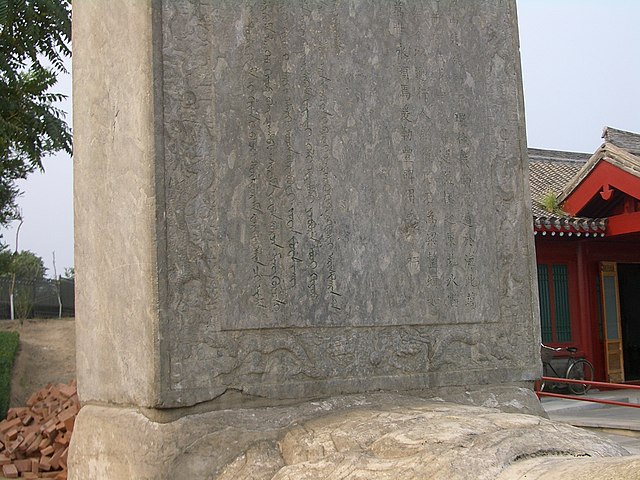Manchu is a critically endangered East Asian Tungusic language native to the historical region of Manchuria in Northeast China. As the traditional native language of the Manchus, it was one of the official languages of the Qing dynasty (1644–1912) of China, although today the vast majority of Manchus speak only Mandarin Chinese. Several thousand can speak Manchu as a second language through governmental primary education or free classes for adults in classrooms or online.
Plaque at the Forbidden City in Beijing, in both Chinese (left, 乾清門; qián qīng mén) and Manchu (right, kiyan cing men)
The Kangxi Emperor's stele near Lugou Bridge, with parallel Chinese and Manchu text
"Banjin Inenggi" and Manchu linguistic activity by the government and students in Changchun, 2011
Manchuria is a term that refers to a region in Northeast Asia encompassing the entirety of present-day Northeast China, and historically parts of the modern-day Russian Far East, often referred to as Outer Manchuria. Its definition may refer to varying geographical extents as follows: the Chinese provinces of Heilongjiang, Jilin, and Liaoning but broadly also including the eastern Inner Mongolian prefectures of Hulunbuir, Hinggan, Tongliao, and Chifeng, collectively known as Northeast China; the aforementioned regions plus the homelands of ancient Jurchen and their descendant Manchus, parts of these region were ceded to the Russian Empire by the Manchu-led Qing dynasty during the Amur Annexation of 1858–1860, which include present-day Amur Oblast, Primorsky Krai, the Jewish Autonomous Oblast, the southern part of Khabarovsk Krai, and the eastern edge of Zabaykalsky Krai, collectively known as the Outer Manchuria or Russian Manchuria.
Hailang River near Hailin City in Heilongjiang
A 12th-century Jurchen stone tortoise in today's Ussuriysk
The Mongol Yuan province of Liaoyang included northern Korea
A Jurchen man hunting from his horse, from a 15th-century ink-and-color painting on silk







